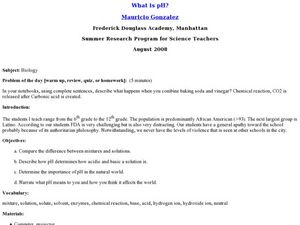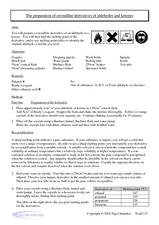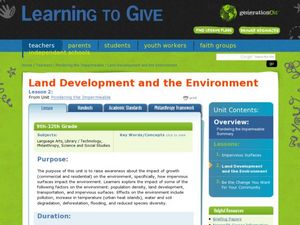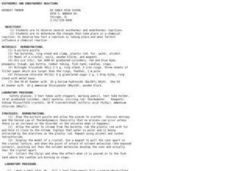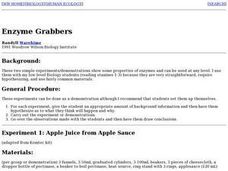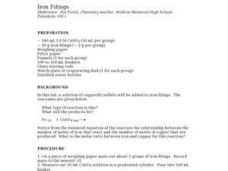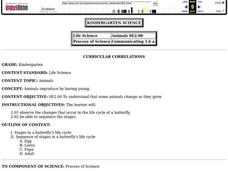Curated OER
Observing the Growth of a Maize Root
Students conduct an experiment in order to observe the typical downward growth of a maize root. They become familiar with the root's growth patterns to use as a control for comparison in other experiments.
Curated OER
Measuring the Effects of Gravistimulation on Plants
High schoolers conduct an experiment to determine if a plant's response to gravity is affected by different angles of plant orientation.
Curated OER
Comparing Roots After Rotation of Ninety Degrees
Students conduct an experiment and use different measurements of a single root to illustrate the mechanism of plant movement.
Curated OER
Root Caps and the Effect on Gravity Sensing
Students conduct an experiment to determine how the absence of a root cap affects a plant's ability to sense gravity. They make comparisons between capped and decapped roots.
Curated OER
What is pH?
Students describe pH and the importance of it in the natural world. In this Biology lesson students compare the pH of different mixtures.
Cornell University
Forensic Science: Case of the Missing Diamond Maker
Someone stole a diamond-making machine. Who done it? Scholars use forensic science at six different stations to determine the culprit. They analyze fingerprints, use their senses, and complete chemistry experiments to determine the...
Curated OER
Preparation of Crystalline Derivatives of Aldehydes and Ketones
Chemistry explorers prepare a crystalline derivative and find its melting point. Once they discover the melting point, they are able to identify whether or not the substance is pure, and whether it is an aldehyde or ketone. This is an...
Curated OER
What is the Percentage of Copper in "Copper" Coins?
Whether in the UK or in the US, the mass of the copper in a copper alloy penny can be determined. If you are in the US, just note that on the lab sheet, a penny is identified as a "1p piece." The penny is dissolved by young chemists in...
LABScI
The Separation Lab: Candy Colors
There's no better motivator than candy! An engaging activity has pupils explore methods for separating mixtures. A two-part lab first explores methods of separation based on size and magnetism. The second activity introduces learners to...
Curated OER
Wetland Metaphors
Students describe the characteristics of wetlands and identify their ecological functions. They inspect items and use them to create metaphors about wetlands.
Kenan Fellows
Reaction Stoichiometry—How Can We Make Chalk?
What is a reasonable percent yield in the manufacturing process? Scholars develop a process for producing chalk in the third lesson of a six-part series. Then, they must determine the theoretical and percent yield. Discussions about...
Curated OER
Where Does Your Garbage Go?
The objective of this lesson is to teach students about the importance of recycling. Initially, students have a chance to think about their impact on our planet by following the path that garbage takes. Students then learn about how...
Curated OER
States of Matter
Students study the states of matter. In this matter lesson, students use dry ice to study the states of matter. Students observe and answer questions based on the material.
Micron Technology Foundation
States of Matter
Solids, liquids, gasses oh my! Young scientists will be amazed when they try this experiment, which uses dry ice to discover the states of matter through sublimation.
Curated OER
Acid/Base Indicators
Students use plant materials as indicators of acids and bases. In this acid/base indicators lesson plan, students use boiled beets, cabbage, flowers, teas or berries that have been boiled with alcohol to test various acids and bases....
Curated OER
Land Development and the Environment
Students examine the relationship between land development and the environment. For this environmental stewardship lesson, students explore how population density, land development, transportation, and impervious surfaces take their toll...
Curated OER
Color and Light Spectrum Demonstrations
Learners explore the light spectrum. The teacher uses holographic diffraction grafting film on an overhead to demonstrate the true nature of color. After observing a vivid rainbow, students recognize that white light is composed of all...
Curated OER
Volumetric Analysis 1- To Make a Standard Solution of Sodium Carbonate
In this volumetric analysis worksheet, students prepare a standard solution of sodium carbonate by following the given directions. They later use the prepared solution in a laboratory practical.
Curated OER
Exothermic and Endothermic Reactions
Students observe demonstrations of exothermic and endothermic reactions and determine the changes that take place in a chemical reaction. Students observe four demonstrations showing entropy, attraction of molecules due to polarity,...
Curated OER
Enzyme Grabbers
Students perform two experiments to show the properties of enzymes. They use pectinase to produce apple juice from applesauce to show enzyme action and then taste the difference between raw and boiled papaya seeds as evidence of enzyme...
Curated OER
Iron Filings
Students conduct an experiment in which a solution of copper(II) sulfate is added to iron filings. They write and balance the equation for the reaction that occurs and calculate the amount of iron that reacted and the percent yield of...
Curated OER
Classroom Composting
Young scholars observe and describe the cyclic nature of life. They identify and appreciate the importance of a balanced ecosystem. Finally, students compare and contrast biodegradable and non-biodegradable resources in nature and...
Curated OER
Butterfly Life Cycle
Students observe and identify the changes that occur in the life cycle of a butterfly. They view photos of each stage of the life cycle, create an art project of the butterfly cycle, and illustrate a book titled "The Life of a Butterfly."
Curated OER
Separation of Mixtures and Compounds For K Through 12
Students explore mixtures and compounds. For this lesson, students do an experiment to distinguish between mixtures and compounds. Students complete ten different phases of the experiment testing many different substances. Students will...






